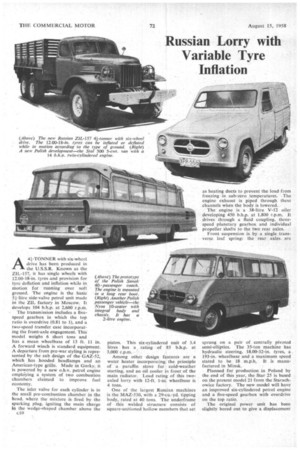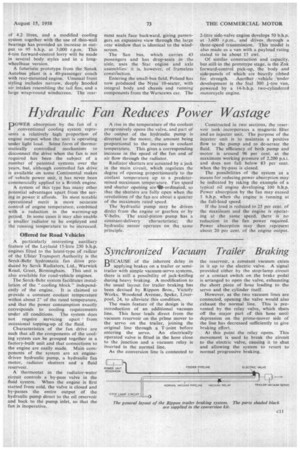Russian Lorry with Variable Tyre Inflation
Page 48

Page 49

If you've noticed an error in this article please click here to report it so we can fix it.
A41-TONNER with six-wheel drive has been produced in the U.S.S.R. Known as the Z1L-157, it has single wheels with 12.00-18-in. tyres and provision for tyre deflation and inflation while in motion for running over soft ground. The engine is the basic 51-litre side-valve petrol unit made in the ZIL factory in Moscow. It develops 104 b.h.p. at 2,600 r.p.m.
The transmission includes a fivespeed gearbox in which the top ratio is overdrive (0.81 to 1), and a two-speed transfer case incorporating the front-axle engagement. This model weighs 6 short tons and has a mean wheelbase of 13 ft. 11 in. A forward winch is standard equipment. A departure from pre-war styling is represented by the cab design of the GAZ-52, which has hooded headlamps and an American-type grille. Made in Gorky, it is powered by a new o.h.v. petrol engine employing a system of two combustion chambers claimed to improve fuel economy.
The inlet valve for each cylinder is in the small pre-combustion chamber in the head, where the mixture is fired by the sparking plug, igniting the main charge in the wedge-shaped chamber above the
piston. This six-cylindered unit of 3.4 litres has a rating of 85 b.h.p. at 3,000 r.p.m.
Among other design features are a water heater incorporating the principle of a paraffin stove for cold-weather starting, and an oil cooler in front of the main radiator. Load rating of this twoaxled lorry with 12-ft. 1-in, wheelbase is 4 tons.
One of the largest Russian machines is the MAZ-530, with a 29-cu.-yd. tipping body, rated at 40 tons. The underframe of this welded structure consists of square-sectioned hollow members that act as heating ducts to prevent the load from freezing in sub-zero temperatures. The engine exhaust is piped through these channels when the body is lowered.
The engine is a 38-litre V-I2 oiler developing 450 b.h.p. at 1,800 r.p.m. It drives through a fluid coupling, threespeed planetary gearbox and individual propeller shafts to the two rear axles. ' Front suspension is by a single transverse leaf spring: the rear axles. are
sprung on a pair of centrally pivoted semi-elliptics. The 35-ton machine has hydraulic steering, 18.00-32-in. tyres, a 193-in. wheelbase and a maximum speed stated to be 18 m.p.h. It is manufactured in Minsk.
Planned for production in Poland by the end of this year, the Star 25 is based on the present model 21 from the Starachowice factory. The new model will have an improved six-cylindered petrol engine and a five-speed gearbox with overdrive on the top ratio. • The original power unit has been slightly bored out to give a displacement
of 4.2 litres, and a modified cooling system together with the use of thin-wall hearings has provided an increase in output to 95 b.h.p. at :3,000 r.p.m. This 4-ton forward-control lorry will be made in several body styles and in a longwheelbase version.
A futuristic prototype from the Sanok Autobus plant is a 40-passenger coach with rear-mounted engine. Unusual front styling includes narrow, deeply hooded air intakes resembling the tail fins, and a large wrap-round windscreen. The rear
mast seats face backward, giving passengers an expansive view through the large rear window that is identical to the windscreen.
The San bus, which carries 43 passengers and has drop-seats in the aisle, uses the Star engine and axle assemblies: it is, however, of frameless construction.
Entering the small-bus field, Poland has now produced the Nysa 10-seater, with integral body and chassis and running components from the Warszawa ear. The
2-litre side-valve engine develops 50 b.h.p. at 3,600 r.p.m., and drives through a three-speed transmission. This model is also made as a van with a payload rating stated to be about 15 cwt.
Of similar construction and capacity, but stillin the prototype stage, is the Zuk forward-control pick-up, the body and side-panels of which are heavily ribbed
for strength. Another ..vehicle under development is the Stal 300 .1-ton van, powered by a 14-b.h.p. two-cylindered motorcycle engine.












































































































